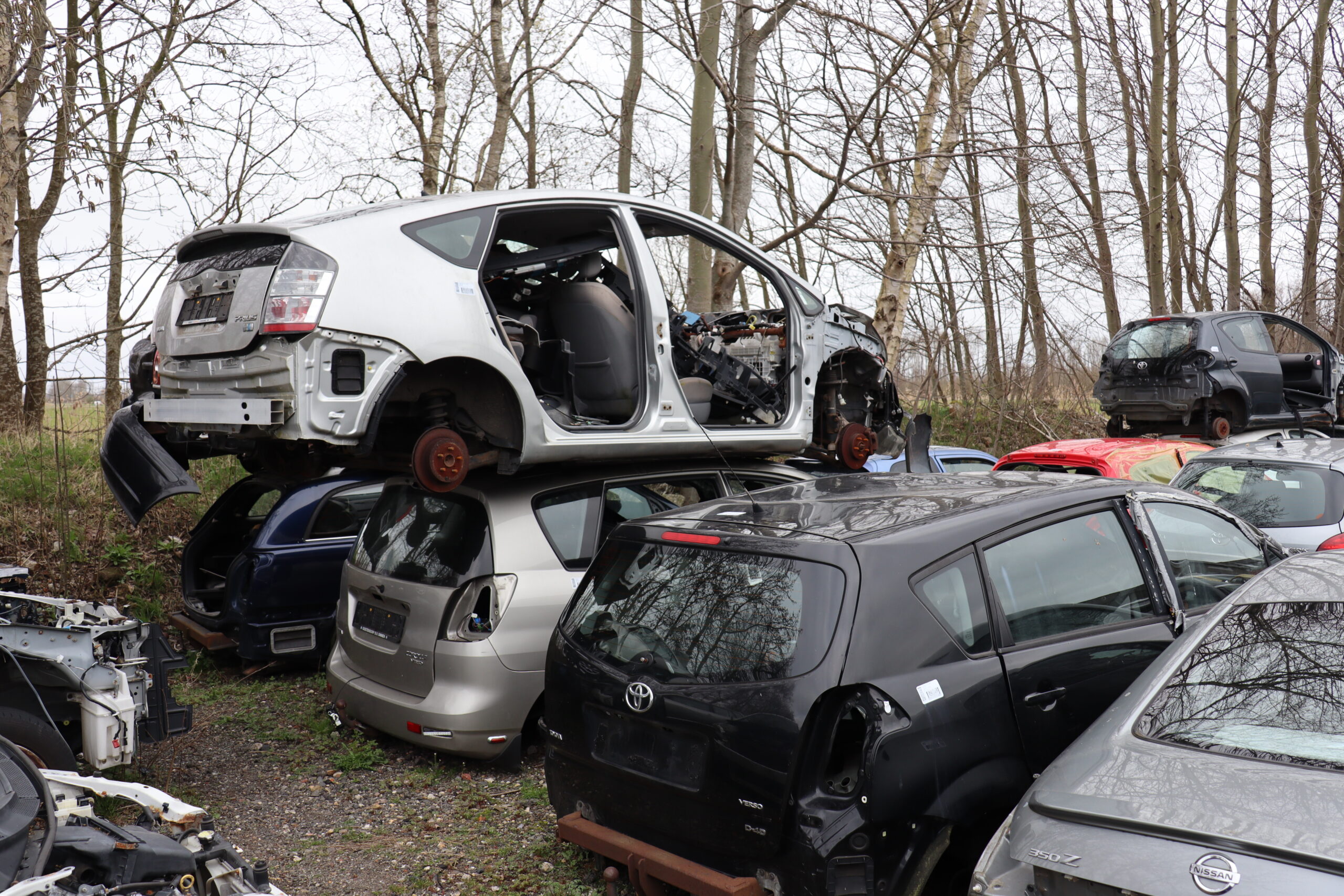They seem to be worlds apart: the rust and grease of the traditional scrapyard versus the clinical stats of ultra modern real-time data analysis. But in today’s modern dismantling business the two are like yin and yang: inextricably linked. CEO Nick van Kessel of Rhenoy BV shares how big data defines his success.
Tekst Leonard van den Berg
Fotografie Klaas Jan Woudsma, De Beeldredaktie
An introduction: Rhenoy BV in Waardenburg is a major player in the car dismantling industry. In the Netherlands, the company has one location with 43 employees at a 32,000 square meter facility. The company also has branches in Poland and Serbia with around 60 employees who, in addition to car dismantling, also service parts and components.
Rhenoy is not your average scrapyard. The company does very little end-of-life vehicles or actual scrapping. The staff specialise in dismantling fairly new damaged cars, around 3,000 a year, returning all valuable parts and materials to the production chain. Rhenoy manages and even supplies surplus batches of new OEM parts. For example unused engine blocks that, because of a change in model, cannot be built in as a new part.
Optimisation with big data
Rhenoy is a staunch user of big data to optimise its business. Van Kessel uses a comprehensive software system that tracks every single car, every part and every transaction throughout all stages; from intake while the piece is still part of a damaged car to dismantling and possible servicing to inventory and delivery to the customer. Instead of developing a proprietary system, he opted for an existing package that does pretty much what he needed. “After a quest that literally took us all around the world, we ended up going with Pinnacle, a US system, developed by car dismantling companies themselves. The dismantling industry is much more developed and much bigger there, with excellent KPIs that provide clear guidance.”
Unique IC code
Together with the original software developers in Scotland, Van Kessel customised the programme to meet his specific needs, encompassing certain legislative and regulatory requirements in the processes and other car makes and models. “Our most important addition was the interchange rules: the unique part description that enables us to describe a part only once. After that, we just tap or click on it. Each part also has a unique IC code that includes the customer’s description (for example, engine or headlamp), combined with specific number codes and OE part numbers for each individual part. Very useful.”
What is the advantage? With its own IC code system that includes more than 60,000 unique part codes, Rhenoy can now also identify parts that are interchangeable between different models and makes. For example a radiator for a Polo that is used in 72 other vehicles. Or a Peugeot engine that is also used in Citroëns, the Ford Focus and the Mini. That gives us multiple opportunities to find the same part in our systems, and then sell it at the best price.”
Higher than the original price
It’s all about the right price. Van Kessel: “The market determines inventory, price and availability. In our business there is little point in looking at the original price or purchase price. It is the current market that determines our resale price. Sometimes it’s even higher than the original purchase price. Pinnacle plays an important role here: when I receive a request for a part, I check the system for three things: how often has it been ordered in the last 180 days, how often did I have it in my inventory and how often have I actually sold it? Our goal is ‘3 sales for 10 inventory occurrences’. When we sell less than 0.3, we are too expensive so we lower the price. Our price adjustments are also automated. Prices constantly fluctuate, providing us with a continuous benchmark.”
Efficient inventory management
Inventory management is also part of the complete package. ”We receive timely out-of-stock reports, so we know when a part is becoming scarce. This allows us to make certain purchasing decisions. We keep 180 days of inventory for each product group. If the inventory gets bigger, we lower the price or stop purchasing.”
The 180-day term matters to Rhenoy for various reasons. Van Kessel: “This is also the term in which we want to achieve at least a break-even on the purchased damaged cars. Let’s say I buy a fairly new damaged car with 200 good parts. Our inventory person will inspect the car with a tablet and taps on each good part that the system wants to keep in inventory. The system knows which parts are highest in demand and that will allow us to break even in 180 days. Those parts receive a code W, for warehouse. The rest of the parts are coded Y for yard. That way everyone knows where to find each part of the car. We keep track of each part until the very last step.
“I can see exactly what revenue a car has generated, which parts are still in stock and what these will generate”
I can track each car, see exactly how much revenue it has generated, which parts are still in stock and what these will generate. Our goal isa cost of goods of 0.45 per car, maximising the car’s value. We will clear at least twice the value of what we originally paid for it. If we manage to do that, we are doing well.”
Winter engine, summer engine
Big data provides more useful insights. “Anytime a new model is launched and we notice an immediate demand for certain replacement parts, which are mostly due to construction issues, and we know we have to look for alternative solutions.”
On the flip side, the system will also indicate which parts will certainly go unsold. That is of course a waste, because demolition is destruction of capital, something that Van Kessel wants to avoid. “But if we have to, we will. And here too we faithfully rely on our system’s advice. When our data reveals that a part isn’t interesting for our inventory, we cease investing time and money in dismantling, cleaning and photographing it.”
Gut feeling
Van Kessel is clearly pleased with his management software. “Thanks to this detailed information, I don’t have to rely on opinions or the gut feeling of my sales staff or myself. We operate purely on data, on facts.
“The advantage? I don’t have to rely on opinions or a gut feeling. We can operate purely based on facts”
By looking at the data, we can see what really matters to our company. Of course, the first time you buy a damaged car from a new model or make you still have to rely on your experience and gut feeling.”
40% unused capacity
Van Kessel believes he can get even more out of his system. “About 40% of our capacity is not being utilized. For example measuring the effectiveness per staff member. I am looking at it, but don’t use it as a firm guideline right now. It doesn’t fit our company. I am happy with our management and our company’s culture. The overall parameters look great and we have the results to proof it. That’s all that matters to me. But of course we always try to optimise. When you stop improving, you stop being good.”
Uniform coding
However, Van Kessel does have a few items left on his wish list. Uniform coding is one. “Our coding is very unique in the world. There is only one other company that works with the same language. The rest of the world cannot understand a word of us. It’s the manufacturers in Europe who are holding up a universal IC code. They negotiated that any parts information to be released can be used exclusively for new OE parts. But that is about to change. Now that recycling and reuse has become a priority in the circular economy, they see parts as a better alternative than (imitation) aftermarket parts. That has resulted in a change in attitude.”
“Our goal is to get the most out of each damaged car, the most value…”
Van Kessel cannot wait for these codes to be released: “When that happens, the industry and the car dismantling companies will be able to really work together. You no longer need to speak Spanish to swap parts with a Spanish company. You can make a work order for the part in the system of a colleague. In the short term there will be a system that will allow car shops to provide quotes based on existing damage calculations using parts from our system and enabling them to immediately order those parts from our system.
Link to OE numbers
Another improvement would be to link with the car manufacturers’ OE numbers, the official part numbers. It’s a political game: it can be done but we need the will. If that happens, the rate of reuse in the automobile industry will increase drastically. “We will have to,” according to Van Kessel. “As a society we have goals we want to achieve. France has made it mandatory for dealers to provide repair quotes that includes the price of used parts. (Ed: read the interview with Albert de Boer about this topic). A growing number of manufacturers are seeing the benefits of reusing parts to achieve their environmental goals. Circular is hot, including for OEMs. Recycling in every stage of the process is at the top of the list: from development to production, maintenance and dismantling. We already supply catalysts, wiring and synthetics that go back to the manufacturers, for example Renault, which reuses these in new cars.”
These changes will also impact on the relationships between OEMs and car dismantling companies, Van Kessel observes. “Before, manufacturers saw us as competitors. Each part we sold was a part they didn’t sell. Now the enemy is the imitation market from China, and OEMs prefer to work with original used parts through us so they can still provide a cheaper alternative to a new part through their dealers. We are no longer the enemy, but an ally.”
Availability becomes obstacle
I am convinced that to provide availability we need good cooperation between the car dismantling companies. The availability of pieces will become the biggest obstacle. When we increase the integration of recycled parts, demand will increase and availability could become a challenge. Especially when the self-driving cars of the future no longer crash. Although when one small part breaks down causing collisions, many cars will start to crash all of a sudden. The future end-of-life vehicle will be very different from today’s vehicles. When we look at connected cars, we see that many components will remain the same. Cars will require more frequent software updates, while the hardware will probably have a shorter life span. The jury is still out on that.”
Could data analysis work for your company?
In addition to the Pinnacle data analysis system that Rhenoy uses, there are several other systems on the market: Automate (by Autonet) and Promasy. These inventory management systems have been especially developed for the car dismantling sector and each offers specific benefits. Would you like to learn more about these systems and see how you can implement these in your company? Click on the links following the brand names.
Think along with us
At ARN, we do the utmost to remain objective. Therefore, we do withhold ourselves from a value judgement with regards to the various commercial systems as described in the text above. In order to give our readers the complete picture, we have listed all of the data-analytics systems in the car dismantling sector that are known to us. We kindly invite you to complete this list.
PinnacleAutomatePromasyMobilox




